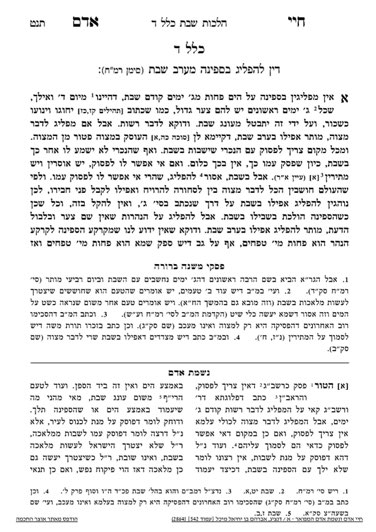We are continuing in siman 1, and left off discussing the modern equivalents for the shiurim given for the 2000 amos of the techum. We learned that there are three primary opinions as to how to calculate an amah. The opinion of Rav Avraham Chaim Naeh ztl is that an amah is rounded to 18 inches. The Chazon Ish disagrees, and holds an amah is 23.7 inches (for our purposes, we will call this 24 inches). Rav Moshe Feinstein held that an amah is 22.5 inches. (Rav Moshe’s opinion is based on calculations made by Rav Dovid Feinstien, ztl, to which Rav Moshe apparently agreed.)
If we translate these measurements to the shiur of 2000 amos, according to Rav Chaim Naeh, it will be 3000 feet. A mile is 5280 feet, so the Rav Chaim Naeh’s measurement comes out to about 3/5th’s of a mile. According to the Chazon Ish, it will be 4000 feet, or about 4/5th’s of a mile. In this situation, the opinion of the Chazon Ish comes out to be lenient.
These measurements apply to the smaller shiur of techum, which all opinions hold is derabanan. The larger shiur, of 12 mil, is a machlokes, and due to the safeik deroaysa, we must be machmir. According to the Chazon Ish, this shiur will be 48,000 feet (rounded), which comes out to a little more than 9 miles. According to Rav Chaim Naeh, it is 36,000 feet, or a little less than 7 miles. Due to the safeik deoraysa, we are machmir to follow Rav Chaim Naeh over here, opposed to the previous case, where we are meikil to follow the Chazon Ish.
Similarly, when measuring whether an item is more than 10 tefachim off the ground, these shiurim will apply as well. The Chazon Ish holds that a tefach is 4 inches, and Rav Chaim Naeh holds it is 3 inches. Going back to our point yesterday about the boat, it would be quite dangerous for the bottom of a boat to be within 30 or 40 inches of the seabed, which is why one can assume they are above 10 tefachim. If the ship were to be that low, it could get grounded. The only time it may be an issue is in a small boat on a shallow stream, as we discussed.
These calculations have applications way beyond techum, including for the size of a tzitzis beged and even the size of a revi’is for kiddush.
To conclude, we see from the discussion that travel on water is a safeik derabanan, and therefore one can be meikil and assume that techum does not apply above 10 tefachim. We digressed to discuss the equivalents for those shiurim because they are important to know.
Another point regarding techum which is important to know is that when we calculate the 2000 amos outside of the city, we do not base it on the contours of the city but rather it is squared off. In other words, we take the furthermost point on each directions of the sides of the city and begin counting the 2000 amos from that point for the entire side. We then join each side to create a square, which, in turn, gains the corners of the square (i.e., the northeast, northwest, southeast and southwest corners).
Summary
- There are two shiurim for techum. The smaller one, of 2000 amos beyond the city, is derabanan. The larger one, of 12 mil (3 parsa), is assumed to be deoraysa.
- The modern equivalents of these shiurim is a machlokes. Rav Chaim Naeh held that an amah is 18 inches, making 2000 amos approximately 3/5th’s of a mile. The Chazon Ish held an amah is 24 inches, making 2000 amos approximately 4/5th’s of a mile.
- Regarding the deoraysa shiur of 12 parsah. Rav Chaim Naeh holds it is approximately 7 miles, and the Chazon Ish holds it is over 9 miles.
- The techum is measured by creating a square around the furthest points from each direction.



